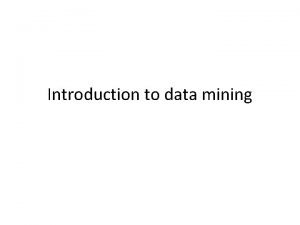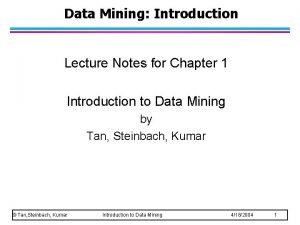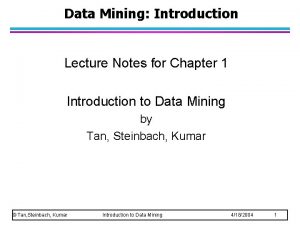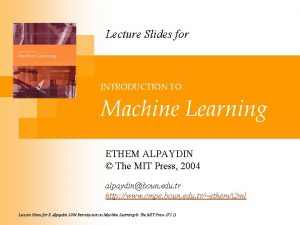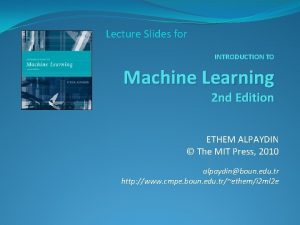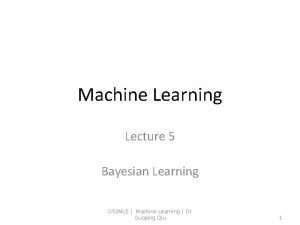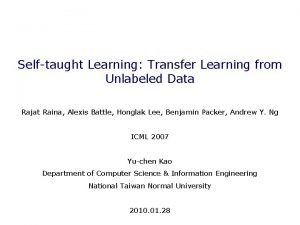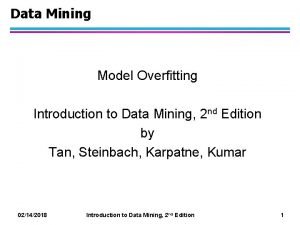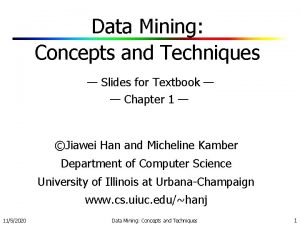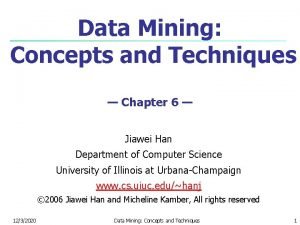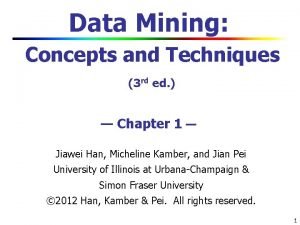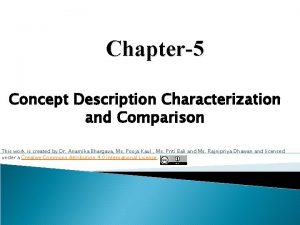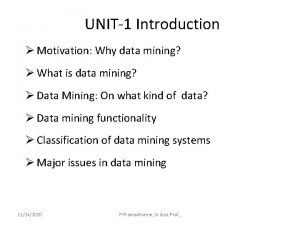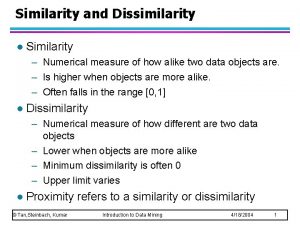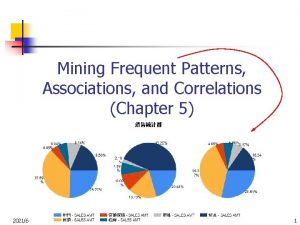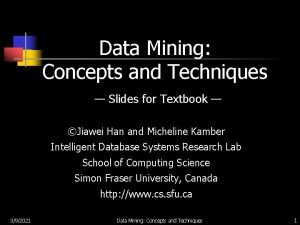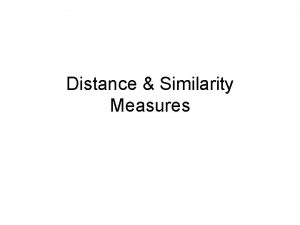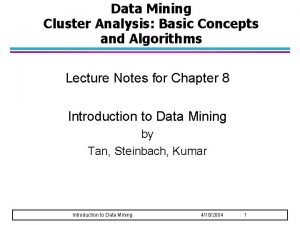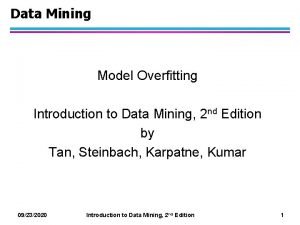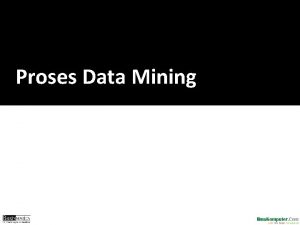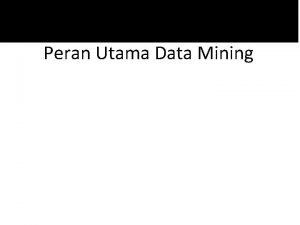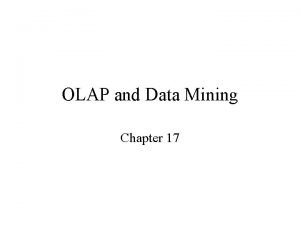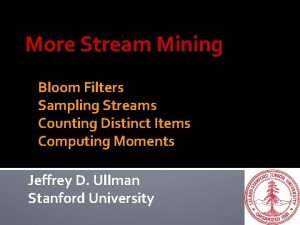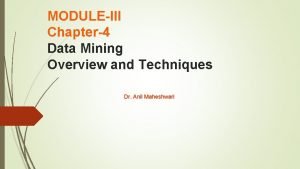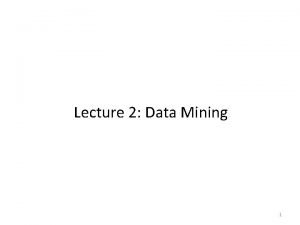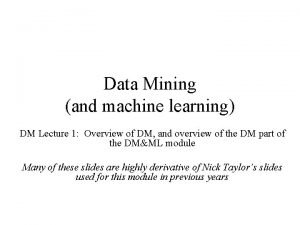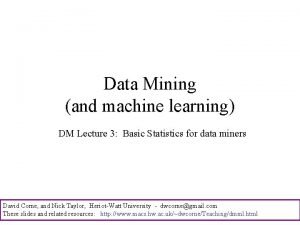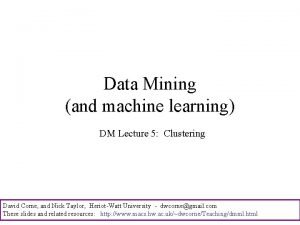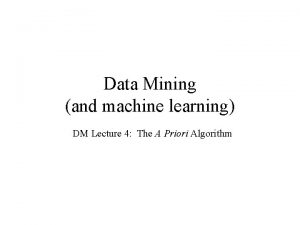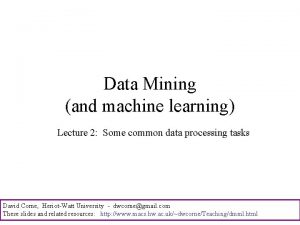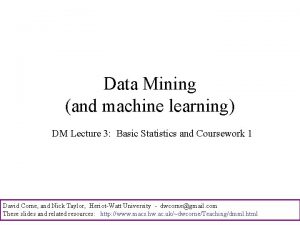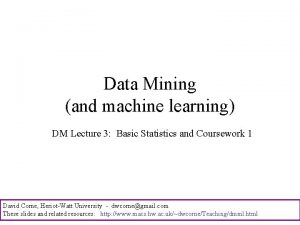Data Mining and machine learning DM Lecture 5




















































































- Slides: 84

Data Mining (and machine learning) DM Lecture 5: Feature Selection

Today Recap/extra correlation/regression: Feature Selection: More on Coursework 2

Remember how to calculate r If we have pairs of (x, y) values, Pearson’s r is:

Equivalently, you can do it like this Looking at it another way: after z-normalisation X is the z-normalised x value in the sample – indicating how many stds away from the mean it is. Same for Y The formula for r on the last slide is equivalent to this:

The names file in the C&C dataset has correlation values (class, target) for each field min Max mean std correlation median mode Population 0 1 0. 06 0. 13 0. 37 0. 02 0. 01 Householdsize 0 1 0. 46 0. 16 -0. 03 0. 44 0. 41 Racepctblack 0 1 0. 18 0. 25 0. 63 0. 06 0. 01 race. Pct. White 0 1 0. 75 0. 24 -0. 68 0. 85 0. 98 race. Pct. Asian 0 1 0. 15 0. 21 0. 04 0. 07 0. 02 race. Pct. Hisp 0 1 0. 14 0. 23 0. 29 0. 04 0. 01 age. Pct 12 t 21 0 1 0. 42 0. 16 0. 06 0. 4 0. 38 age. Pct 12 t 29 0 1 0. 49 0. 14 0. 15 0. 48 0. 49 age. Pct 16 t 24 0 1 0. 34 0. 17 0. 1 0. 29 age. Pct 65 up 0 1 0. 42 0. 18 0. 07 0. 42 0. 47 numb. Urban 0 1 0. 06 0. 13 0. 36 0. 03 0 pct. Urban 0 1 0. 7 0. 44 0. 08 1 1 med. Income 0 1 0. 36 0. 21 -0. 42 0. 32 0. 23 pct. WWage 0 1 0. 56 0. 18 -0. 31 0. 56 0. 58 pct. WFarm. Self 0 1 0. 29 0. 2 -0. 15 0. 23 0. 16 pct. WInv. Inc 0 1 0. 5 0. 18 -0. 58 0. 41 pct. WSoc. Sec 0 1 0. 47 0. 12 0. 475 0. 56 pct. WPub. Asst 0 1 0. 32 0. 22 0. 57 0. 26 0. 1 pct. WRetire 0 1 0. 48 0. 17 -0. 1 0. 47 0. 44 med. Fam. Inc 0 1 0. 38 0. 2 -0. 44 0. 33 0. 25 per. Cap. Inc 0 1 0. 35 0. 19 -0. 35 0. 3 0. 23

here … min Max mean std correlation median mode Population 0 1 0. 06 0. 13 0. 37 0. 02 0. 01 Householdsize 0 1 0. 46 0. 16 -0. 03 0. 44 0. 41 Racepctblack 0 1 0. 18 0. 25 0. 63 0. 06 0. 01 race. Pct. White 0 1 0. 75 0. 24 -0. 68 0. 85 0. 98 race. Pct. Asian 0 1 0. 15 0. 21 0. 04 0. 07 0. 02 race. Pct. Hisp 0 1 0. 14 0. 23 0. 29 0. 04 0. 01 age. Pct 12 t 21 0 1 0. 42 0. 16 0. 06 0. 4 0. 38 age. Pct 12 t 29 0 1 0. 49 0. 14 0. 15 0. 48 0. 49 age. Pct 16 t 24 0 1 0. 34 0. 17 0. 1 0. 29 age. Pct 65 up 0 1 0. 42 0. 18 0. 07 0. 42 0. 47 numb. Urban 0 1 0. 06 0. 13 0. 36 0. 03 0 pct. Urban 0 1 0. 7 0. 44 0. 08 1 1 med. Income 0 1 0. 36 0. 21 -0. 42 0. 32 0. 23 pct. WWage 0 1 0. 56 0. 18 -0. 31 0. 56 0. 58 pct. WFarm. Self 0 1 0. 29 0. 2 -0. 15 0. 23 0. 16 pct. WInv. Inc 0 1 0. 5 0. 18 -0. 58 0. 41 pct. WSoc. Sec 0 1 0. 47 0. 12 0. 475 0. 56 pct. WPub. Asst 0 1 0. 32 0. 22 0. 57 0. 26 0. 1 pct. WRetire 0 1 0. 48 0. 17 -0. 1 0. 47 0. 44 med. Fam. Inc 0 1 0. 38 0. 2 -0. 44 0. 33 0. 25 per. Cap. Inc 0 1 0. 35 0. 19 -0. 35 0. 3 0. 23 white. Per. Cap 0 1 0. 37 0. 19 -0. 21 0. 32 0. 3

Here are the top 20 (although the first doesn’t count) - this hints at how we might use correlation for feature selection Violent. Crimes. Per. Pop 0 1 0. 24 0. 23 1 0. 15 0. 03 0 Pct. Illeg 0 1 0. 25 0. 23 0. 74 0. 17 0. 09 0 Pct. Kids 2 Par 0 1 0. 62 0. 21 -0. 74 0. 64 0. 72 0 Pct. Fam 2 Par 0 1 0. 61 0. 2 -0. 71 0. 63 0. 7 0 race. Pct. White 0 1 0. 75 0. 24 -0. 68 0. 85 0. 98 0 Pct. Young. Kids 2 Par 0 1 0. 66 0. 22 -0. 67 0. 91 0 Pct. Teen 2 Par 0 1 0. 58 0. 19 -0. 66 0. 61 0. 6 0 racepctblack 0 1 0. 18 0. 25 0. 63 0. 06 0. 01 0 pct. WInv. Inc 0 1 0. 5 0. 18 -0. 58 0. 41 0 pct. WPub. Asst 0 1 0. 32 0. 22 0. 57 0. 26 0. 1 0 Female. Pct. Div 0 1 0. 49 0. 18 0. 56 0. 54 0 Total. Pct. Div 0 1 0. 49 0. 18 0. 55 0. 57 0 Pct. Polic. Black 0 1 0. 22 0. 24 0. 54 0. 12 0 1675 Male. Pct. Divorce 0 1 0. 46 0. 18 0. 53 0. 47 0. 56 0 Pct. Pers. Own. Occup 0 1 0. 56 0. 2 -0. 53 0. 56 0. 54 0 Pct. Pop. Under. Pov 0 1 0. 3 0. 23 0. 52 0. 25 0. 08 0 Pct. Unemployed 0 1 0. 36 0. 2 0. 5 0. 32 0. 24 0 Pct. Hous. No. Phone 0 1 0. 26 0. 24 0. 49 0. 185 0. 01 0 Pct. Polic. Minor 0 1 0. 26 0. 23 0. 49 0. 2 0. 07 1675 Pct. Not. HSGrad 0 1 0. 38 0. 2 0. 48 0. 36 0. 39 0

Can anyone see a potential problem with choosing only (for example) the 20 features that correlate best with the target class ?

Feature Selection: What You have some data, and you want to use it to build a classifier, so that you can predict something (e. g. likelihood of cancer)

Feature Selection: What You have some data, and you want to use it to build a classifier, so that you can predict something (e. g. likelihood of cancer) The data has 10, 000 fields (features)

Feature Selection: What You have some data, and you want to use it to build a classifier, so that you can predict something (e. g. likelihood of cancer) The data has 10, 000 fields (features) you need to cut it down to 1, 000 fields before you try machine learning. Which 1, 000?

Feature Selection: What You have some data, and you want to use it to build a classifier, so that you can predict something (e. g. likelihood of cancer) The data has 10, 000 fields (features) you need to cut it down to 1, 000 fields before you try machine learning. Which 1, 000? The process of choosing the 1, 000 fields to use is called Feature Selection

Datasets with many features Gene expression datasets (~10, 000 features) http: //www. ncbi. nlm. nih. gov/sites/entrez? db=gds Proteomics data (~20, 000 features) http: //www. ebi. ac. uk/pride/ Satellite image data … Weather data …. .

Feature Selection: Why?

Feature Selection: Why?

Feature Selection: Why? From http: //elpub. scix. net/data/works/att/02 -28. content. pdf

Quite easy to find lots more cases from papers, where experiments show that accuracy reduces when you use more features

• Why does accuracy reduce with more features? • How does it depend on the specific choice of features? • What else changes if we use more features? • So, how do we choose the right features?

Why accuracy reduces: • Note: suppose the best feature set has 20 features. If you add another 5 features, typically the accuracy of machine learning may reduce. But you still have the original 20 features!! Why does this happen? ? ?

Noise / Spurious Correlations / Explosion • The additional features typically add noise. Machine learning will pick up on spurious correlations, that might be true in the training set, but not in the test set. • For some ML methods, more features means more parameters to learn (more NN weights, more decision tree nodes, etc…) – the increased space of possibilities is more difficult to search.

Feature selection methods

Feature selection methods A big research area! This diagram from (Dash & Liu, 1997) We’ll look briefly at parts of it

Feature selection methods

Feature selection methods

Correlation-based feature ranking This is what you will use in CW 2. It is indeed used often, by practitioners (who perhaps don’t understand the issues involved in FS) It is actually fine for certain datasets. It is not even considered in Dash & Liu’s survey.

A made-up dataset f 1 f 2 f 3 f 4 … class 0. 4 0. 6 1 0. 2 0. 4 1. 6 -0. 6 1 0. 5 0. 7 1. 8 -0. 8 1 0. 7 0. 8 0. 2 0. 9 0. 8 1. 8 -0. 7 2 0. 5 0. 6 0. 5 2

Correlated with the class f 1 f 2 f 3 f 4 … class 0. 4 0. 6 1 0. 2 0. 4 1. 6 -0. 6 1 0. 5 0. 7 1. 8 -0. 8 1 0. 7 0. 8 0. 2 0. 9 0. 8 1. 8 -0. 7 2 0. 5 0. 6 0. 5 2

uncorrelated with the class / seemingly random f 1 f 2 f 3 f 4 … class 0. 4 0. 6 1 0. 2 0. 4 1. 6 -0. 6 1 0. 5 0. 7 1. 8 -0. 8 1 0. 7 0. 8 0. 2 0. 9 0. 8 1. 8 -0. 7 2 0. 5 0. 6 0. 5 2 David Corne, and Nick Taylor, Heriot-Watt University - dwcorne@gmail. com These slides and related resources: http: //www. macs. hw. ac. uk/~dwcorne/Teaching/dmml. html

Correlation based FS reduces the dataset to this. f 1 f 2 … class 0. 4 0. 6 1 0. 2 0. 4 1 0. 5 0. 7 1 0. 7 0. 8 2 0. 9 0. 8 2 0. 5 2

But, col 5 shows us f 3 + f 4 – which is perfectly correlated with the class! f 1 f 2 f 3 f 4 … class 0. 4 0. 6 1 1 0. 2 0. 4 1. 6 -0. 6 1 1 0. 5 0. 7 1. 8 -0. 8 1 1 0. 7 0. 8 0. 2 0. 9 1. 1 2 0. 9 0. 8 1. 8 -0. 7 1. 1 2 0. 5 0. 6 0. 5 1. 1 2

Good FS Methods therefore: • Need to consider how well features work together • As we have noted before, if you take 100 features that are each well correlated with the class, they may simply be correlated strongly with each other, so provide no more information than just one of them

`Complete’ methods Original dataset has N features You want to use a subset of k features A complete FS method means: try every subset of k features, and choose the best! the number of subsets is N! / k!(N−k)! what is this when N is 100 and k is 5?

`Complete’ methods Original dataset has N features You want to use a subset of k features A complete FS method means: try every subset of k features, and choose the best! the number of subsets is N! / k!(N−k)! what is this when N is 100 and k is 5? 75, 287, 520 -- almost nothing

`Complete’ methods Original dataset has N features You want to use a subset of k features A complete FS method means: try every subset of k features, and choose the best! the number of subsets is N! / k!(N−k)! what is this when N is 10, 000 and k is 100?

`Complete’ methods Original dataset has N features You want to use a subset of k features A complete FS method means: try every subset of k features, and choose the best! the number of subsets is N! / k!(N−k)! what is this when N is 10, 000 and k is 100? 5, 000, 000, 000, Continued 1 …. .

000, 000, 000, 000, 000, 000, 000, 000, 000, 000, 000, 000, 000, 000, 000, 000, 000, 000, 000, 000, 000, 000, 000, 000, 000, Continued 2 …. .

000, 000, 000, 000, 000, 000, 000, 000, 000, 000, 000, 000, 000, 000, 000, 000, 000, 000, 000, 000, 000, 000, 000, 000, 000, Continued 3 …. .

000, 000, 000, 000, 000, 000, 000, 000, 000, 000, 000, 000, 000, 000, 000, 000, 000, 000, 000, 000, 000, 000, 000, 000, 000, Continued 4 …. .

… continued for another 114 slides. Actually it is around 5 × 1035, 101 (there around 1080 atoms in the universe)

Can you see a problem with complete methods?

`Forward’ methods These methods `grow’ a set S of features – • S starts empty • Find the best feature to add (by checking which one gives best performance on a test set when combined with S). • If overall performance has improved, return to step 2; else stop

Forward selection illustrated F 1 F 2 F 3 F 4 F 5 F 6 F 7 F 8 F 9 Etc … 2 5 65 67 2 2 12 2 234 … 1 2 4 5 13 1 1 43 12 … 4 3 43 2 4 6 2 2 1 … 5 4 2 3 5 5 13 1 2 … 3 5 1 4 7 3 4 6 13 … 2 2 6 5 7 1 5 4 4 … 1 3 4 4 55 4 7 55 43 … Selected feature set {}

Test each feature in turn to find out which works best with current feature set … F 1 F 2 F 3 F 4 F 5 F 6 F 7 F 8 F 9 Etc … 2 5 65 67 2 2 12 2 234 … 1 2 4 5 13 1 1 43 12 … 4 3 43 2 4 6 2 2 1 … 5 4 2 3 5 5 13 1 2 … 3 5 1 4 7 3 4 6 13 … 2 2 6 5 7 1 5 4 4 … 1 3 4 4 55 4 7 55 43 … Selected feature set {}

Test each feature in turn to find out which works best with current feature set … F 1 F 2 F 3 F 4 F 5 F 6 F 7 F 8 F 9 Etc … 2 5 65 67 2 2 12 2 234 … 1 2 4 5 13 1 1 43 12 … 4 3 43 2 4 6 2 2 1 … 5 4 2 3 5 5 13 1 2 … 3 5 1 4 7 3 4 6 13 … 2 2 6 5 7 1 5 4 4 … 1 3 4 4 55 4 7 55 43 … 65% Selected feature set {}

Test each feature in turn to find out which works best with current feature set … F 1 F 2 F 3 F 4 F 5 F 6 F 7 F 8 F 9 Etc … 2 5 65 67 2 2 12 2 234 … 1 2 4 5 13 1 1 43 12 … 4 3 43 2 4 6 2 2 1 … 5 4 2 3 5 5 13 1 2 … 3 5 1 4 7 3 4 6 13 … 2 2 6 5 7 1 5 4 4 … 1 3 4 4 55 4 7 55 43 … 58% Selected feature set {}

Test each feature in turn to find out which works best with current feature set … F 1 F 2 F 3 F 4 F 5 F 6 F 7 F 8 F 9 Etc … 2 5 65 67 2 2 12 2 234 … 1 2 4 5 13 1 1 43 12 … 4 3 43 2 4 6 2 2 1 … 5 4 2 3 5 5 13 1 2 … 3 5 1 4 7 3 4 6 13 … 2 2 6 5 7 1 5 4 4 … 1 3 4 4 55 4 7 55 43 … 54% Selected feature set {}

Test each feature in turn to find out which works best with current feature set … F 1 F 2 F 3 F 4 F 5 F 6 F 7 F 8 F 9 Etc … 2 5 65 67 2 2 12 2 234 … 1 2 4 5 13 1 1 43 12 … 4 3 43 2 4 6 2 2 1 … 5 4 2 3 5 5 13 1 2 … 3 5 1 4 7 3 4 6 13 … 2 2 6 5 7 1 5 4 4 … 1 3 4 4 55 4 7 55 43 … 72% Selected feature set {}

Test each feature in turn to find out which works best with current feature set … F 1 F 2 F 3 F 4 F 5 F 6 F 7 F 8 F 9 Etc … 2 5 65 67 2 2 12 2 234 … 1 2 4 5 13 1 1 43 12 … 4 3 43 2 4 6 2 2 1 … 5 4 2 3 5 5 13 1 2 … 3 5 1 4 7 3 4 6 13 … 2 2 6 5 7 1 5 4 4 … 1 3 4 4 55 4 7 55 43 … 64% Selected feature set {}

Etc F 1 F 2 F 3 F 4 F 5 F 6 F 7 F 8 F 9 Etc … 2 5 65 67 2 2 12 2 234 … 1 2 4 5 13 1 1 43 12 … 4 3 43 2 4 6 2 2 1 … 5 4 2 3 5 5 13 1 2 … 3 5 1 4 7 3 4 6 13 … 2 2 6 5 7 1 5 4 4 … 1 3 4 4 55 4 7 55 43 … 65% 58% 54% 72% 64% 61% 62% 25% 49% …. Selected feature set {}

Add the winning feature to the selected feature set F 1 F 2 F 3 F 4 F 5 F 6 F 7 F 8 F 9 Etc … 2 5 65 67 2 2 12 2 234 … 1 2 4 5 13 1 1 43 12 … 4 3 43 2 4 6 2 2 1 … 5 4 2 3 5 5 13 1 2 … 3 5 1 4 7 3 4 6 13 … 2 2 6 5 7 1 5 4 4 … 1 3 4 4 55 4 7 55 43 … 65% 58% 54% 72% 64% Selected feature set {F 4} 61% 62% 25% 49% ….

We have completed one ‘round’ of forward selection F 1 F 2 F 3 F 4 F 5 F 6 F 7 F 8 F 9 Etc … 2 5 65 67 2 2 12 2 234 … 1 2 4 5 13 1 1 43 12 … 4 3 43 2 4 6 2 2 1 … 5 4 2 3 5 5 13 1 2 … 3 5 1 4 7 3 4 6 13 … 2 2 6 5 7 1 5 4 4 … 1 3 4 4 55 4 7 55 43 … 65% 58% 54% 72% 64% Selected feature set {F 4} 61% 62% 25% 49% ….

Test each feature in turn to find out which works best with current feature set … F 1 F 2 F 3 F 4 F 5 F 6 F 7 F 8 F 9 Etc … 2 5 65 67 2 2 12 2 234 … 1 2 4 5 13 1 1 43 12 … 4 3 43 2 4 6 2 2 1 … 5 4 2 3 5 5 13 1 2 … 3 5 1 4 7 3 4 6 13 … 2 2 6 5 7 1 5 4 4 … 1 3 4 4 55 4 7 55 43 … Selected feature set {F 4}

Test each feature in turn to find out which works best with current feature set … F 1 F 2 F 3 F 4 F 5 F 6 F 7 F 8 F 9 Etc … 2 5 65 67 2 2 12 2 234 … 1 2 4 5 13 1 1 43 12 … 4 3 43 2 4 6 2 2 1 … 5 4 2 3 5 5 13 1 2 … 3 5 1 4 7 3 4 6 13 … 2 2 6 5 7 1 5 4 4 … 1 3 4 4 55 4 7 55 43 … 61% Selected feature set {F 4}

Test each feature in turn to find out which works best with current feature set … F 1 F 2 F 3 F 4 F 5 F 6 F 7 F 8 F 9 Etc … 2 5 65 67 2 2 12 2 234 … 1 2 4 5 13 1 1 43 12 … 4 3 43 2 4 6 2 2 1 … 5 4 2 3 5 5 13 1 2 … 3 5 1 4 7 3 4 6 13 … 2 2 6 5 7 1 5 4 4 … 1 3 4 4 55 4 7 55 43 … 59% Selected feature set {F 4}

Test each feature in turn to find out which works best with current feature set … F 1 F 2 F 3 F 4 F 5 F 6 F 7 F 8 F 9 Etc … 2 5 65 67 2 2 12 2 234 … 1 2 4 5 13 1 1 43 12 … 4 3 43 2 4 6 2 2 1 … 5 4 2 3 5 5 13 1 2 … 3 5 1 4 7 3 4 6 13 … 2 2 6 5 7 1 5 4 4 … 1 3 4 4 55 4 7 55 43 … 58% Selected feature set {F 4}

Test each feature in turn to find out which works best with current feature set … F 1 F 2 F 3 F 4 F 5 F 6 F 7 F 8 F 9 Etc … 2 5 65 67 2 2 12 2 234 … 1 2 4 5 13 1 1 43 12 … 4 3 43 2 4 6 2 2 1 … 5 4 2 3 5 5 13 1 2 … 3 5 1 4 7 3 4 6 13 … 2 2 6 5 7 1 5 4 4 … 1 3 4 4 55 4 7 55 43 … Selected feature set {F 4}

Test each feature in turn to find out which works best with current feature set … F 1 F 2 F 3 F 4 F 5 F 6 F 7 F 8 F 9 Etc … 2 5 65 67 2 2 12 2 234 … 1 2 4 5 13 1 1 43 12 … 4 3 43 2 4 6 2 2 1 … 5 4 2 3 5 5 13 1 2 … 3 5 1 4 7 3 4 6 13 … 2 2 6 5 7 1 5 4 4 … 1 3 4 4 55 4 7 55 43 … 66% Selected feature set {F 4}

Etc F 1 F 2 F 3 F 4 F 5 F 6 F 7 F 8 F 9 Etc … 2 5 65 67 2 2 12 2 234 … 1 2 4 5 13 1 1 43 12 … 4 3 43 2 4 6 2 2 1 … 5 4 2 3 5 5 13 1 2 … 3 5 1 4 7 3 4 6 13 … 2 2 6 5 7 1 5 4 4 … 1 3 4 4 55 4 7 55 43 … 61% 59% 58% 66% 68% 75% 47% 49% …. Selected feature set {F 4}

Add the winning feature to the selected feature set F 1 F 2 F 3 F 4 F 5 F 6 F 7 F 8 F 9 Etc … 2 5 65 67 2 2 12 2 234 … 1 2 4 5 13 1 1 43 12 … 4 3 43 2 4 6 2 2 1 … 5 4 2 3 5 5 13 1 2 … 3 5 1 4 7 3 4 6 13 … 2 2 6 5 7 1 5 4 4 … 1 3 4 4 55 4 7 55 43 … 61% 59% 58% 66% 68% 75% 47% 49% …. Selected feature set {F 4, F 7}

We have completed the second ‘round’ of forward selection F 1 F 2 F 3 F 4 F 5 F 6 F 7 F 8 F 9 Etc … 2 5 65 67 2 2 12 2 234 … 1 2 4 5 13 1 1 43 12 … 4 3 43 2 4 6 2 2 1 … 5 4 2 3 5 5 13 1 2 … 3 5 1 4 7 3 4 6 13 … 2 2 6 5 7 1 5 4 4 … 1 3 4 4 55 4 7 55 43 … 61% 59% 58% 66% 68% 75% 47% 49% …. Selected feature set {F 4, F 7}

Continue… adding one feature after each round, until overall accuracy starts to reduce F 1 F 2 F 3 F 4 F 5 F 6 F 7 F 8 F 9 Etc … 2 5 65 67 2 2 12 2 234 … 1 2 4 5 13 1 1 43 12 … 4 3 43 2 4 6 2 2 1 … 5 4 2 3 5 5 13 1 2 … 3 5 1 4 7 3 4 6 13 … 2 2 6 5 7 1 5 4 4 … 1 3 4 4 55 4 7 55 43 … 61% 59% 58% 66% 68% 75% 47% 49% …. Selected feature set {F 4, F 7}

`Backward’ methods These methods remove features one by one. • S starts with the full feature set • Find the best feature to remove (by checking which removal from S gives best performance on a test set). • If overall performance has improved, return to step 2; else stop

• When might you choose forward instead of backward?

Random(ised) methods aka Stochastic methods Suppose you have 1, 000 features. There are 21000 possible subsets of features. One way to try to find a good subset is to run a stochastic search algorithm E. g. Hillclimbing, simulated annealing, genetic algorithm, particle swarm optimisation, …

Example to give flavour of heuristic methods Forward selection works by, in each round, adding ONE feature to the growing set, having tried every feature in turn. If there are 50, 000 features, how many steps in each round?

Example to give flavour of heuristic methods Forward selection works by, in each round, adding ONE feature to the growing set, having tried every feature in turn. If there are 50, 000 features, how many steps in each round? What if, in each round, you wanted to find the best pair of features to add, how many steps would there be per round?

Example to give flavour of heuristic methods Forward selection works by, in each round, adding ONE feature to the growing set, having tried every feature in turn. If there are 50, 000 features, how many steps in each round? What if, in each round, you wanted to find the best pair of features to add, how many steps would there be per round? So, what could you do instead, to make this a workable method?

Why randomised/search methods are good for FS Usually you have a large number of features (e. g. 1, 000) You can give each feature a score (e. g. correlation with target, Relief weight (see end slides), etc …), and choose the best-scoring features. This is very fast. However this does not evaluate how well features work with other features. You could give combinations of features a score, but there are too many combinations of multiple features. Search algorithms are the only suitable approach that get to grips with evaluating combinations of features.

If time: the classic example of an instance-based heuristic method

The Relief method An instance-based, heuristic method – it works out weight values for Each feature, based on how important they seem to be in discriminating between near neighbours

The Relief method There are two features here – the x and the y co-ordinate Initially they each have zero weight: wx = 0; wy = 0;

The Relief method wx = 0; wy = 0; choose an instance at random

The Relief method wx = 0; wy = 0; choose an instance at random, call it R

The Relief method wx = 0; wy = 0; find H (hit: the nearest to R of the same class) and M (miss: the nearest to R of different class)

The Relief method wx = 0; wy = 0; find H (hit: the nearest to R of the same class) and M (miss: the nearest to R of different class) M H

The Relief method wx = 0; wy = 0; now we update the weights based on the distances between R and H and between R and M. This happens one feature at a time M H

The Relief method To change wx, we add to it: (MR − HR)/n ; so, the further the `miss’ in the x direction, the higher the weight of x – the more important x is in terms of discriminating the classes M H MR HR

The Relief method To change wy, we add to it: (MR − HR)/n again, but this time calculated in the y dimension; clearly the difference is smaller; differences in this feature don’t seem important in terms of class value M H MR HR

The Relief method Maybe now we have wx = 0. 07, wy = 0. 002.

The Relief method wx = 0. 07, wy = 0. 002; Pick another instance at random, and do the same again.

The Relief method wx = 0. 07, wy = 0. 002; Identify H and M H M

The Relief method wx = 0. 07, wy = 0. 002; Add the HR and MR differences divided by n, for each feature, again … H M

The Relief method In the end, we have a weight value for each feature. The higher the value, the more relevant the feature. We can use these weights for feature selection, simply by choosing the features with the S highest weights (if we want to use S features) NOTE -It is important to use Relief F only on min-max normalised data in [0, 1]. However it is fine if category attibutes are involved, in which case use Hamming distance for those attributes, -Why divide by n? Then, the weight values can be interpreted as a difference in probabilities.

The Relief method, plucked directly from the original paper (Kira and Rendell 1992)
 Mining complex data types
Mining complex data types Machine learning and data mining
Machine learning and data mining Introduction to azure ml
Introduction to azure ml Mining multimedia databases
Mining multimedia databases Bayesian classification in data mining lecture notes
Bayesian classification in data mining lecture notes Data mining lecture notes
Data mining lecture notes Data mining lecture notes
Data mining lecture notes Data mining lecture notes
Data mining lecture notes Andrew ng machine learning slides
Andrew ng machine learning slides Machine learning lecture notes
Machine learning lecture notes Machine learning lecture notes
Machine learning lecture notes Difference between strip mining and open pit mining
Difference between strip mining and open pit mining Web text mining
Web text mining What is kdd process in data mining
What is kdd process in data mining Datamart olap
Datamart olap Olap
Olap Introduction to data warehouse
Introduction to data warehouse Unsupervised learning in data mining
Unsupervised learning in data mining Supervised learning dan unsupervised learning
Supervised learning dan unsupervised learning Inductive and analytical learning
Inductive and analytical learning In analytical learning hypothesis fits
In analytical learning hypothesis fits Eager learning
Eager learning Strip mining vs open pit mining
Strip mining vs open pit mining Strip mining before and after
Strip mining before and after 01:640:244 lecture notes - lecture 15: plat, idah, farad
01:640:244 lecture notes - lecture 15: plat, idah, farad Data reduction in data mining
Data reduction in data mining What is missing data in data mining
What is missing data in data mining Data reduction in data mining
Data reduction in data mining Data reduction in data mining
Data reduction in data mining Data reduction in data mining
Data reduction in data mining Shell cube in data mining
Shell cube in data mining Data reduction in data mining
Data reduction in data mining Data warehouse dan data mining
Data warehouse dan data mining Perbedaan data warehouse dan data mining
Perbedaan data warehouse dan data mining Mining complex data objects
Mining complex data objects Noisy data in data mining
Noisy data in data mining 4 tier architecture of data warehouse
4 tier architecture of data warehouse Data preparation for data mining
Data preparation for data mining Data compression in data mining
Data compression in data mining Data warehouse dan data mining
Data warehouse dan data mining Cs 412 introduction to data mining
Cs 412 introduction to data mining Concept learning task in machine learning
Concept learning task in machine learning Analytical learning in machine learning
Analytical learning in machine learning Pac learning model in machine learning
Pac learning model in machine learning Machine learning t mitchell
Machine learning t mitchell Instance based learning in machine learning
Instance based learning in machine learning Inductive learning machine learning
Inductive learning machine learning First order rule learning in machine learning
First order rule learning in machine learning Deep learning vs machine learning
Deep learning vs machine learning Cuadro comparativo de e-learning
Cuadro comparativo de e-learning Bsp classification
Bsp classification Training data in machine learning with example
Training data in machine learning with example Anesthesia hose
Anesthesia hose Self-taught learning: transfer learning from unlabeled data
Self-taught learning: transfer learning from unlabeled data Underfitting and overfitting in data mining
Underfitting and overfitting in data mining Data mining concepts and techniques
Data mining concepts and techniques Underfitting and overfitting in data mining
Underfitting and overfitting in data mining Function of data mining
Function of data mining Characterization and comparison in data mining
Characterization and comparison in data mining Data mining primitives languages and system architecture
Data mining primitives languages and system architecture Motivation of data mining
Motivation of data mining Similarity and dissimilarity measures in data mining
Similarity and dissimilarity measures in data mining Reporting and query tools in data mining
Reporting and query tools in data mining Associations and correlations in data mining
Associations and correlations in data mining Classification and clustering in data mining
Classification and clustering in data mining Associations and correlations in data mining
Associations and correlations in data mining Data mining concepts and techniques slides
Data mining concepts and techniques slides Introduction to data mining and knowledge discovery
Introduction to data mining and knowledge discovery Collection of data objects
Collection of data objects Data mining concepts and techniques slides
Data mining concepts and techniques slides Smc vs jaccard
Smc vs jaccard Cluster analysis in data mining
Cluster analysis in data mining Overfitting in data mining
Overfitting in data mining Data mining languages and system architecture
Data mining languages and system architecture Moore machine
Moore machine Differentiate between simple machine and compound machine
Differentiate between simple machine and compound machine Pump it up: data mining the water table
Pump it up: data mining the water table Tahapan utama data mining
Tahapan utama data mining Algoritma estimasi yang biasa digunakan adalah
Algoritma estimasi yang biasa digunakan adalah Oltp cube
Oltp cube Bloom filter for stream data mining
Bloom filter for stream data mining Data mining steps
Data mining steps Data mining exam
Data mining exam Multidimensional space in data mining
Multidimensional space in data mining Data mining roadmap
Data mining roadmap

